[Editor’s Note: Mad Scientist Laboratory is pleased to publish today’s guest blog post by MAJ Vincent Dueñas, addressing how AI can mitigate a human commander’s cognitive biases and enhance his/her (and their staff’s) decision-making, freeing them to do what they do best — command, fight, and win on future battlefields!]
 Humans are susceptible to cognitive biases and these biases sometimes result in catastrophic outcomes, particularly in the high stress environment of war-time decision-making. Artificial Intelligence (AI) offers the possibility of mitigating the susceptibility of negative outcomes in the commander’s decision-making process by enhancing the collective Emotional Intelligence (EI) of the commander and his/her staff. AI will continue to become more prevalent in combat and as such, should be integrated in a way that advances
Humans are susceptible to cognitive biases and these biases sometimes result in catastrophic outcomes, particularly in the high stress environment of war-time decision-making. Artificial Intelligence (AI) offers the possibility of mitigating the susceptibility of negative outcomes in the commander’s decision-making process by enhancing the collective Emotional Intelligence (EI) of the commander and his/her staff. AI will continue to become more prevalent in combat and as such, should be integrated in a way that advances  the EI capacity of our commanders. An interactive AI that feels like one is communicating with a staff officer, which has human-compatible principles, can support decision-making in high-stakes, time-critical situations with ambiguous or incomplete information.
the EI capacity of our commanders. An interactive AI that feels like one is communicating with a staff officer, which has human-compatible principles, can support decision-making in high-stakes, time-critical situations with ambiguous or incomplete information.
Mission Command in the Army is the exercise of authority and direction by the commander using mission orders to enable disciplined initiative within the commander’s intent.i It requires an environment of mutual trust and shared understanding between the commander and his subordinates in order to understand, visualize, describe, and direct throughout the decision-making Operations Process and mass the effects of combat power.ii
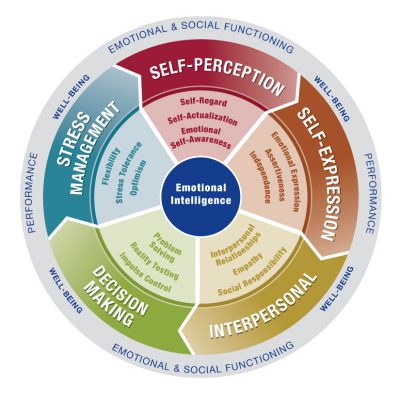 The mission command philosophy necessitates improved EI. EI is defined as the capacity to be aware of, control, and express one’s emotions, and to handle interpersonal relationships judiciously and empathetically, at much quicker speeds in order seize the initiative in war.iii The more effective our commanders are at EI, the better they lead, fight, and win using all the tools available.
The mission command philosophy necessitates improved EI. EI is defined as the capacity to be aware of, control, and express one’s emotions, and to handle interpersonal relationships judiciously and empathetically, at much quicker speeds in order seize the initiative in war.iii The more effective our commanders are at EI, the better they lead, fight, and win using all the tools available.
AI Staff Officer
To conceptualize how AI can enhance decision-making on the battlefields of the future, we must understand that AI today is advancing more quickly in narrow problem solving domains than in those that require broad understanding.iv This means that, for now, humans continue to retain the advantage in broad information assimilation.  The advent of machine-learning algorithms that could be applied to autonomous lethal weapons systems has so far resulted in a general predilection towards ensuring humans remain in the decision-making loop with respect to all aspects of warfare.v, vi AI’s near-term niche will continue to advance rapidly in narrow domains and become a more useful interactive assistant capable of analyzing not only the systems it manages, but the very users themselves. AI could be used to provide detailed analysis and aggregated assessments for the commander at the key decision points that require a human-in-the-loop interface.
The advent of machine-learning algorithms that could be applied to autonomous lethal weapons systems has so far resulted in a general predilection towards ensuring humans remain in the decision-making loop with respect to all aspects of warfare.v, vi AI’s near-term niche will continue to advance rapidly in narrow domains and become a more useful interactive assistant capable of analyzing not only the systems it manages, but the very users themselves. AI could be used to provide detailed analysis and aggregated assessments for the commander at the key decision points that require a human-in-the-loop interface.
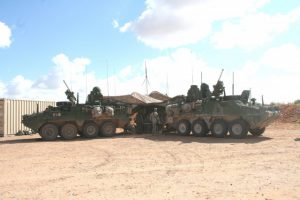 The Battalion is a good example organization to visualize this framework. A machine-learning software system could be connected into different staff systems to analyze data produced by the section as they execute their warfighting functions. This machine-learning software system would also assess the human-in-the-loop decisions against statistical outcomes and aggregate important data to support the commander’s
The Battalion is a good example organization to visualize this framework. A machine-learning software system could be connected into different staff systems to analyze data produced by the section as they execute their warfighting functions. This machine-learning software system would also assess the human-in-the-loop decisions against statistical outcomes and aggregate important data to support the commander’s 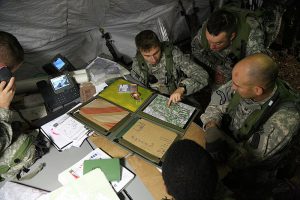 assessments. Over time, this EI-based machine-learning software system could rank the quality of the staff officers’ judgements. The commander can then consider the value of the staff officers’ assessments against the officers’ track-record of reliability and the raw data provided by the staff sections’ systems. The Bridgewater financial firm employs this very type of human decision-making assessment algorithm in order to assess the
assessments. Over time, this EI-based machine-learning software system could rank the quality of the staff officers’ judgements. The commander can then consider the value of the staff officers’ assessments against the officers’ track-record of reliability and the raw data provided by the staff sections’ systems. The Bridgewater financial firm employs this very type of human decision-making assessment algorithm in order to assess the  “believability” of their employees’ judgements before making high-stakes, and sometimes time-critical, international financial decisions.vii Included in such a multi-layered machine-learning system applied to the battalion, there would also be an assessment made of the commander’s own reliability, to maximize objectivity.
“believability” of their employees’ judgements before making high-stakes, and sometimes time-critical, international financial decisions.vii Included in such a multi-layered machine-learning system applied to the battalion, there would also be an assessment made of the commander’s own reliability, to maximize objectivity.
Observations by the AI of multiple iterations of human behavioral patterns during simulations and real-world operations would improve its accuracy and enhance the trust between this type of AI system and its users. Commanders’ EI skills would be put front and center for scrutiny and could improve drastically by virtue of the weight of the responsibility of consciously knowing the cognitive bias shortcomings of the staff with quantifiable evidence, at any given time. This assisted decision-making AI framework would also consequently reinforce the commander’s intuition and decisions as it elevates the level of objectivity in decision-making.
Human-Compatibility
The capacity to understand information broadly and conduct unsupervised learning remains the virtue of humans for the foreseeable future.viii The integration of AI into the battlefield should work towards enhancing the EI of the commander since it supports mission command and complements the human advantage in decision-making. Giving the AI the feel of a staff officer implies also providing it with a framework for how it might begin to understand the information it is receiving and the decisions being made by the commander.
 Stuart Russell offers a construct of limitations that should be coded into AI in order to make it most useful to humanity and prevent conclusions that result in an AI turning on humanity. These three concepts are: 1) principle of altruism towards the human race (and not itself), 2) maximizing uncertainty by making it follow only human objectives, but not explaining what those are, and 3) making it learn by exposing it to everything and all types of humans.ix
Stuart Russell offers a construct of limitations that should be coded into AI in order to make it most useful to humanity and prevent conclusions that result in an AI turning on humanity. These three concepts are: 1) principle of altruism towards the human race (and not itself), 2) maximizing uncertainty by making it follow only human objectives, but not explaining what those are, and 3) making it learn by exposing it to everything and all types of humans.ix
Russell’s principles offer a human-compatible guide for AI to be useful within the human decision-making process, protecting humans from unintended consequences of the AI making decisions on its own. The integration of these principles in battlefield AI systems would provide the best chance of ensuring the AI serves as an assistant to the commander, enhancing his/her EI to make better decisions.
Making AI Work
 The potential opportunities and pitfalls are abundant for the employment of AI in decision-making. Apart from the obvious danger of this type of system being hacked, the possibility of the AI machine-learning algorithms harboring biased coding inconsistent with the values of the unit employing it are real.
The potential opportunities and pitfalls are abundant for the employment of AI in decision-making. Apart from the obvious danger of this type of system being hacked, the possibility of the AI machine-learning algorithms harboring biased coding inconsistent with the values of the unit employing it are real.
 The commander’s primary goal is to achieve the mission. The future includes AI, and commanders will need to trust and integrate AI assessments into their natural decision-making process and make it part of their intuitive calculus. In this way, they will have ready access to objective analyses of their units’ potential biases, enhancing their own EI, and be able overcome them to accomplish their mission.
The commander’s primary goal is to achieve the mission. The future includes AI, and commanders will need to trust and integrate AI assessments into their natural decision-making process and make it part of their intuitive calculus. In this way, they will have ready access to objective analyses of their units’ potential biases, enhancing their own EI, and be able overcome them to accomplish their mission.
If you enjoyed this post, please also read:
An Appropriate Level of Trust…
Takeaways Learned about the Future of the AI Battlefield
MAJ Vincent Dueñas is an Army Foreign Area Officer and has deployed as a cavalry and communications officer. His writing on national security issues, decision-making, and international affairs has been featured in Divergent Options, Small Wars Journal, and The Strategy Bridge. MAJ Dueñas is a member of the Military Writers Guild and a Term Member with the Council on Foreign Relations. The views reflected are his own and do not represent the opinion of the United States Government or any of its agencies.
i United States, Army, States, United. “ADRP 5-0 2012: The Operations Process.” ADRP 5-0 2012: The Operations Process, Headquarters, Dept. of the Army., 2012, pp. 1–1.
ii Ibid. pp. 1-1 – 1-3.
iii “Emotional Intelligence | Definition of Emotional Intelligence in English by Oxford Dictionaries.” Oxford Dictionaries | English, Oxford Dictionaries, 2018, en.oxforddictionaries.com/definition/emotional_intelligence.
iv Trent, Stoney, and Scott Lathrop. “A Primer on Artificial Intelligence for Military Leaders.” Small Wars Journal, 2018, smallwarsjournal.com/index.php/jrnl/art/primer-artificial-intelligence-military-leaders.
v Scharre, Paul. ARMY OF NONE: Autonomous Weapons and the Future of War. W W NORTON, 2019.
vi Evans, Hayley. “Lethal Autonomous Weapons Systems at the First and Second U.N. CGE Meetings.” Lawfare, 2018, https://www.lawfareblog.com/lethal-autonomous-weapons-systems-first-and-second-un-gge-meetings.
vii Dalio, Ray. Principles. Simon and Schuster, 2017.
viii Trent and Lathrop.
ix Russell, Stuart, director. Three Principles for Creating Safer AI. TED: Ideas Worth Spreading, 2017, www.ted.com/talks/stuart_russell_3_principles_for_creating_safer_ai.



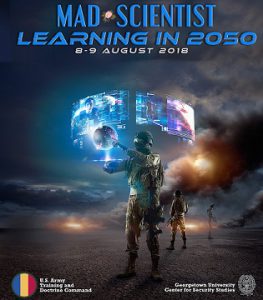 [Editor’s Note: On 8-9 August 2018, the U.S. Army Training and Doctrine Command (TRADOC) co-hosted the Mad Scientist Learning in 2050 Conference with Georgetown University’s Center for Security Studies in Washington, DC. Leading scientists, innovators, and scholars from academia, industry, and the government gathered to address future learning techniques and technologies that are critical in preparing for Army operations in the mid-21st century against adversaries in rapidly evolving battlespaces. Today’s post is extracted from this conference’s final report (more of which is addressed at the bottom of this post).]
[Editor’s Note: On 8-9 August 2018, the U.S. Army Training and Doctrine Command (TRADOC) co-hosted the Mad Scientist Learning in 2050 Conference with Georgetown University’s Center for Security Studies in Washington, DC. Leading scientists, innovators, and scholars from academia, industry, and the government gathered to address future learning techniques and technologies that are critical in preparing for Army operations in the mid-21st century against adversaries in rapidly evolving battlespaces. Today’s post is extracted from this conference’s final report (more of which is addressed at the bottom of this post).] The U.S. Army currently has more than 150
The U.S. Army currently has more than 150 Training eighty thousand new Recruits a year on existing MOSs is a colossal undertaking. A great expansion in the jobs and skillsets needed to field a highly capable future Army, replete with modified or new MOSs, adds a considerable burden to the Army’s learning systems and institutions. These new requirements, however, will almost certainly present an opportunity for the Army to capitalize on intelligent tutors, personalized learning, and immersive learning to lessen costs and save time in Soldier and Leader development.
Training eighty thousand new Recruits a year on existing MOSs is a colossal undertaking. A great expansion in the jobs and skillsets needed to field a highly capable future Army, replete with modified or new MOSs, adds a considerable burden to the Army’s learning systems and institutions. These new requirements, however, will almost certainly present an opportunity for the Army to capitalize on intelligent tutors, personalized learning, and immersive learning to lessen costs and save time in Soldier and Leader development. Marc Prensky, educational writer and speaker who coined the term digital native, asserts this “
Marc Prensky, educational writer and speaker who coined the term digital native, asserts this “ variety of intrinsic skills that Recruits will have prior to entering the Army. Just like we no longer train Soldiers on how to use a computer, games like Fortnite, with no formal relationship with the military, will provide players with militarily-useful skills such as communications, resource management, foraging, force structure management, and fortification and structure building, all while attempting to survive against persistent attack. Due to these trends, Recruits may come into the Army with fundamental technical skills and baseline military thinking attributes that flatten the learning curve for Initial Entry Training (IET).
variety of intrinsic skills that Recruits will have prior to entering the Army. Just like we no longer train Soldiers on how to use a computer, games like Fortnite, with no formal relationship with the military, will provide players with militarily-useful skills such as communications, resource management, foraging, force structure management, and fortification and structure building, all while attempting to survive against persistent attack. Due to these trends, Recruits may come into the Army with fundamental technical skills and baseline military thinking attributes that flatten the learning curve for Initial Entry Training (IET). Due to the high demand for these skillsets, the Army will have to compete for talent with private industry, battling them on compensation, benefits, perks, and a less restrictive work environment – limited to no dress code, flexible schedule, and freedom of action. In light of this, the Army may have to consider adjusting or relaxing its current recruitment processes, business practices, and force structuring to ensure it is able to attract and retain expertise. It also may have to reconsider how it adapts and utilizes its civilian workforce to undertake these types of tasks in new and creative ways.
Due to the high demand for these skillsets, the Army will have to compete for talent with private industry, battling them on compensation, benefits, perks, and a less restrictive work environment – limited to no dress code, flexible schedule, and freedom of action. In light of this, the Army may have to consider adjusting or relaxing its current recruitment processes, business practices, and force structuring to ensure it is able to attract and retain expertise. It also may have to reconsider how it adapts and utilizes its civilian workforce to undertake these types of tasks in new and creative ways. The Army is already exploring this avenue of approach through the formation of an
The Army is already exploring this avenue of approach through the formation of an
 A recent study identified 34
A recent study identified 34 Hue, and Ramadi, shift the perspective from problem solving to critical holistic thinking skills and decision-making required in ambiguous environments.
Hue, and Ramadi, shift the perspective from problem solving to critical holistic thinking skills and decision-making required in ambiguous environments.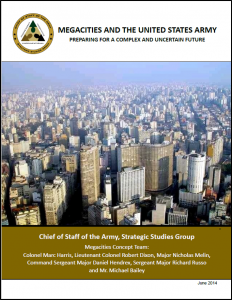 The
The become self-ruling and long-term sustainable, would facilitate urban, political, and economical homeostasis in alignment with U.S. interests and bequeath a homeostatic urban balance legacy — “Pax Americana.”
become self-ruling and long-term sustainable, would facilitate urban, political, and economical homeostasis in alignment with U.S. interests and bequeath a homeostatic urban balance legacy — “Pax Americana.” This is naturally ongoing in Detroit, is historically documented to have happened in Rome, and can be witnessed in Angkor Wat. While the greatest beneficiaries of this long-term would be the populace, its military benefits are obvious. The Army would simply accelerate the process.
This is naturally ongoing in Detroit, is historically documented to have happened in Rome, and can be witnessed in Angkor Wat. While the greatest beneficiaries of this long-term would be the populace, its military benefits are obvious. The Army would simply accelerate the process.
 Editor’s Note: Mad Scientist Laboratory is pleased to provide for your holiday reading pleasure our
Editor’s Note: Mad Scientist Laboratory is pleased to provide for your holiday reading pleasure our select the “Confirm Follow” blue button in the subsequent email you receive. In doing so, you’ll stay connected with all things Mad Scientist!
select the “Confirm Follow” blue button in the subsequent email you receive. In doing so, you’ll stay connected with all things Mad Scientist!


 Success in the future OE relies on many key assumptions. One such assumption is that the innovation cycle has flipped. Where the DoD used to drive technological innovation in this country, we now see private industry (namely Silicon Valley) as the driving force with the Army consuming products and transitioning technology for military use. If this system is to work, as the assumption implies, the Army must be able to work easily with the country’s leading technology companies. Microsoft’s President Brad Smith stated recently that his company will “provide the U.S. military with access to the best technology … all the technology we create. Full stop.”
Success in the future OE relies on many key assumptions. One such assumption is that the innovation cycle has flipped. Where the DoD used to drive technological innovation in this country, we now see private industry (namely Silicon Valley) as the driving force with the Army consuming products and transitioning technology for military use. If this system is to work, as the assumption implies, the Army must be able to work easily with the country’s leading technology companies. Microsoft’s President Brad Smith stated recently that his company will “provide the U.S. military with access to the best technology … all the technology we create. Full stop.”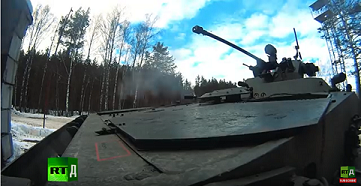
 The retail superpower Walmart is employing hundreds of robots in stores across the country, starting next month. These floor-scrubbing janitor robots will keep the stores’ floors immaculate using autonomous navigation that will be able to sense both people and obstacles.
The retail superpower Walmart is employing hundreds of robots in stores across the country, starting next month. These floor-scrubbing janitor robots will keep the stores’ floors immaculate using autonomous navigation that will be able to sense both people and obstacles.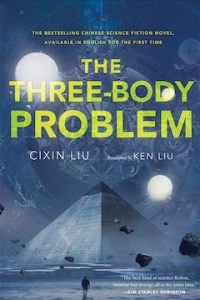 Russia, and Africa. This rise of global science fiction challenges how we think about the evolution of the genre. Historically, our occidental bias led us to believe that sci-fi was spreading from Western centers out to the rest of the world, blinding us to the fact that other regions also have rich histories of sci-fi depicting future possibilities from their cultural perspectives. Chinese science fiction has boomed in recent years, with standout books like Cixin Liu’s
Russia, and Africa. This rise of global science fiction challenges how we think about the evolution of the genre. Historically, our occidental bias led us to believe that sci-fi was spreading from Western centers out to the rest of the world, blinding us to the fact that other regions also have rich histories of sci-fi depicting future possibilities from their cultural perspectives. Chinese science fiction has boomed in recent years, with standout books like Cixin Liu’s  A significant barrier to the modeling and simulation of dense urban environments has been the complexity of these areas in terms of building, vehicle, pedestrian, and foliage density.
A significant barrier to the modeling and simulation of dense urban environments has been the complexity of these areas in terms of building, vehicle, pedestrian, and foliage density.